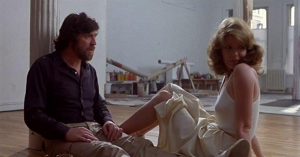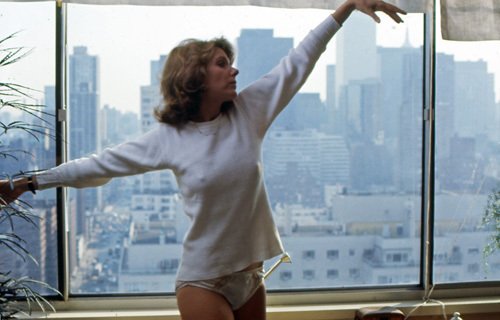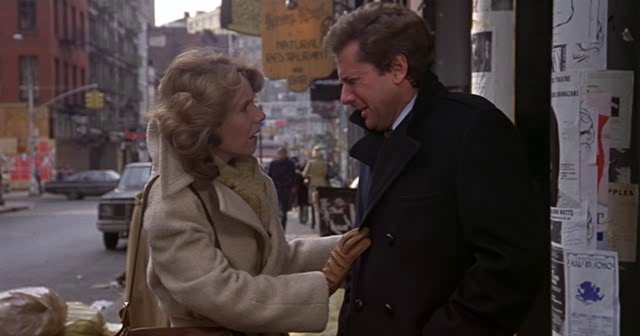Previously, we have looked at films that feature the hopeful beginning of a marriage and the midway turning point of one. By the late 70s, the subject of divorce was in the air. No longer was it socially contained by its being classified as primarily part of the terrain of working-class life, like in Wanda (1970).
Rather, divorce became visible as the generation that started the decade with hopes for the kinds of relationships developed out of the opportunities provided by the sexual revolution started to see these hopes fade. In many cases, such hopes were flimsy from the start, as patriarchal ideology, receiving, at best, inadequate examination, acted to constrain movements for social equality throughout the 70s.
The film we will now discuss looks at the effects of divorce in upper-class New York City. Its perspective, then, is limited in social scope, but incisive in showing how class-based thinking about gender relationships can be built on illusions of comfort and compromise.
A Tale of Two Lunches: An Unmarried Woman
(dir Mazursky, 1978)
After having lunch together, Erica’s husband, Martin, suddenly breaks down and confesses that he has been having a year-long affair with a younger woman. Erica’s reaction is first to make an acerbic joke, asking him if the other woman was a good lay. Then Erica dashes around the corner and throws up. The scene graphically depicts the differences between how feelings of shock can be processed mentally and physically.
An Unmarried Woman suggests the difficulty of balancing the mind and body, without privileging either one. This puts a critical spin on the conflict between independence and loneliness. It is also, crucially, a gendered issue, because as a newly “unmarried” woman, it seems every guy in Erica’s proximity makes a pass at her. At another lunch, this time with Elaine, her best friend, and Elaine’s current boyfriend, Erica meets one of their male friends who impulsively gets in the cab she takes to return home. When she acts defensively, telling him she’s not dating, he says in his neighborhood lunch counts as a date. The scene turns horrifying as he tries to kiss her. She fights back, curses at him, and gets the cab driver to stop and let him out.
Thus the first lesson Erica learns is that it is hard to preserve her independence when guys blatantly stare at her, sizing her up as a potential conquest. Her being trapped as a woman feeling both vulnerable and lonely tends to equalize her being rather obsessive in dwelling in her unhappiness–what we might call now a sign of class-based privilege.
It becomes apparent that one of the reasons for Erica’s obsessiveness is that she has for a long time been able to find in her marriage a solution to the problem of loneliness. Marriage is shown to be attractive because it dulls feelings of discomfort with a world that shuts down emotional connections: especially in the paved-over, status-conscious environment of New York City. But the film cynically proposes that marriage appears, at best, a temporary solution. Martin shows us the results of not being able to feel independent enough and not discussing his situation openly with Erica. The younger woman he is seeing serves as an excuse to pursue a freer life—not an unusual occurrence, as we all sadly know, that spells out a major consequence of male mid-life crisis.
Especially in its portrayal of city life, the film resembles a slice of drab realism set against a rather florid, and dated, horn and strings soundtrack. There is an absence of fancy camerawork (rather noticeable in the era of open artistic license for directors), save for occasional shots of people looking into or reflected in mirrors, a signifier of the ongoing self-reflection that shades into self-absorption.
Given the film’s moody tone, Jill Clayburgh who plays Erica, shines (her performance nominated for an Oscar). She exudes a physicality in her healthy libido and interests in jogging and ballet. She is also stunningly open in her expression of emotions, like in the dialogue-free scene where she tries to clear mental and physical space by piling Martin’s things in a corner of the apartment, adding her wedding ring to the pile. Her anger certainly does seem real, as she feels betrayed by her husband’s leaving her.
In a role somewhat similar to the sleazy campaign manager in Nashville (1975), Michael Murphy plays Martin. While he does appear genuine in his desire to not hurt his wife and daughter, he seems blissfully unaware of how difficult it would be to fulfill such a desire, noble as it might be. He also acts as a frustrated idealist, growing tired of his lucrative job in the financial sector that pays for a life of relative luxury for him and his family. Such is his idealism that he even tries to reconcile with Erica after being dumped by his girlfriend.
Erica has obviously thought about the possibilities of reconciliation, but flatly refuses. It is, the film perhaps suggests, a sign of her developing feminist thinking, bolstered by female-bonding with friends (all unmarried, like Erica) and therapy sessions. Earlier in a fight with Martin after he leaves her, she questions the difference between being a wife and a whore. Moments like these are overheated in an almost comical way, counterbalanced by Elaine’s advice not to give into depression, into which anger must invariably turn.
Yet the depiction of feminism comes off as rather superficial, even trendy, like the guru that Elaine tries to talk Erica into going with her to see. In another scene that suddenly shifts from being sentimental to disturbing, Erica and her friends lament the lack of worthwhile causes to take up, even going so far as to classify war as one of them. Considering the recent devastation of Vietnam, it seems a rather ignorant and offensive statement to make—as if their compulsive soul searching has left these well-off women disconnected from a far more desperate world.
These scenes though do feel deliberate, as if An Unmarried Woman, as few films really do, is critically looking at the distinctions between feminism as a discussion topic and as active practice. The film does raise the stakes by featuring Erica’s daughter as both an observer and participant in the family conflict, suggesting that her generation will have to take up the same issues as her parents.
 The film’s closing becomes more predictable, while retaining a cynical edge. Erica meets Saul, a handsome artist, albeit with a not unsubstantial amount of past baggage. Encouraged by Elaine, who is free-floating on prescribed antidepressants, Erica moves into a new place to start a new life, presumably with Saul. This, however, remains a large presumption, for Erica watches him leave the city for the summer. Still holding onto her independence, Erica stays behind. She walks down the street, carrying an oversized painting of his given to her as a parting gift.
The film’s closing becomes more predictable, while retaining a cynical edge. Erica meets Saul, a handsome artist, albeit with a not unsubstantial amount of past baggage. Encouraged by Elaine, who is free-floating on prescribed antidepressants, Erica moves into a new place to start a new life, presumably with Saul. This, however, remains a large presumption, for Erica watches him leave the city for the summer. Still holding onto her independence, Erica stays behind. She walks down the street, carrying an oversized painting of his given to her as a parting gift.
If the film illustrates how, for a woman, balancing independence with a successful love life is a tricky endeavor, Erica comes off as fairly well-adjusted, avoiding the psychic turbulence that the free-spirited Mabel, in A Woman Under the Influence (1974), had to face. Like that film directed and written by John Cassavetes, An Unmarried Woman, besides having a similar-sounding title, invites us to think about how we feel about the female protagonist at the end. Is Erica just shuffling her hurt from her husband onto another guy? Is the artist like her husband, who will try to mold and shape Erica into what he desires?
In a more critical model of feminism, which the film does not show us but seems to suggest is necessary, answers to these questions may not be as comforting as we might like. That is because all women are certainly not the same in how they would consider freedom weighed against security—class and race, we ought to remember, can play a formidable role in the decision-making process.


